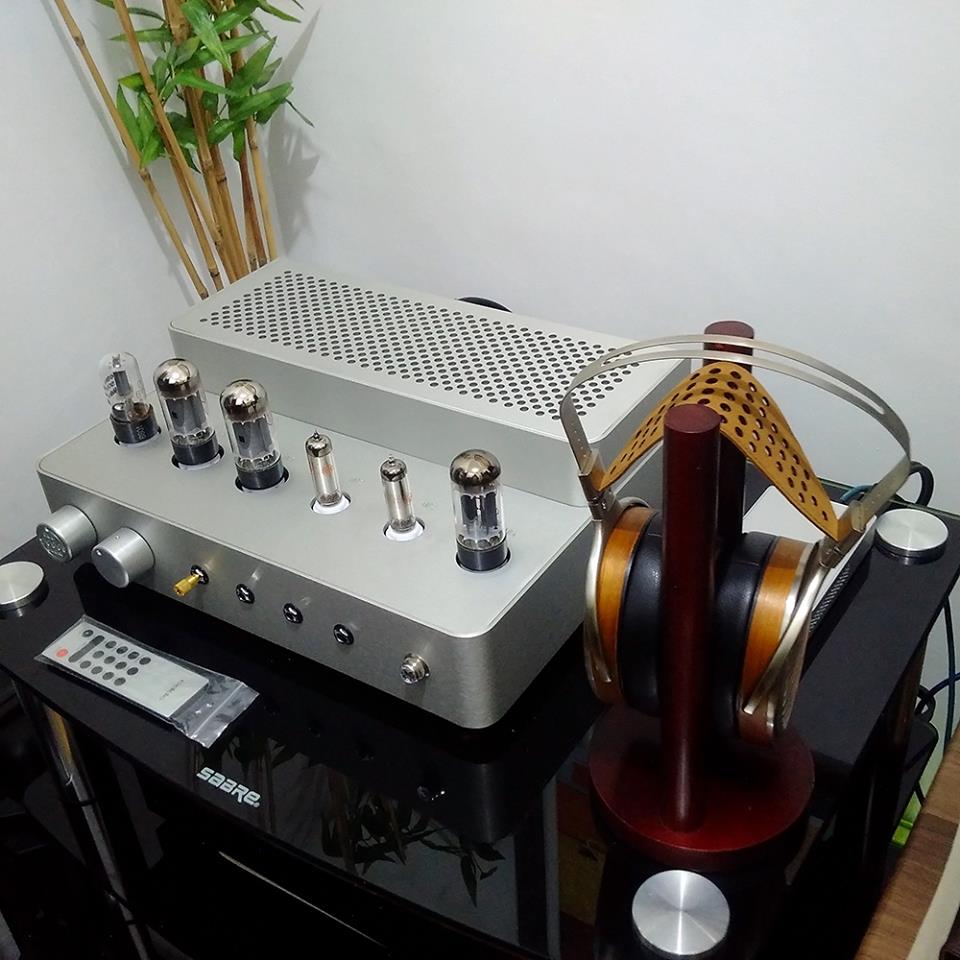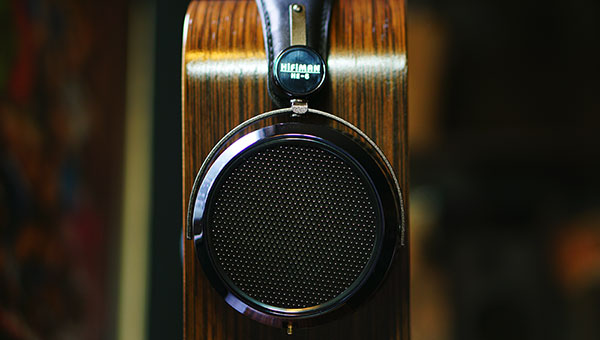Synergy
The Power Equation
When the HE-6 came out and to some extent, the LCDs from Audeze the big issue with these planar flagships was finding the right amp that could power them adequately.
The HE-6 is just not efficient at 83.5dB and I do not think anyone is trying to excuse this long-standing fact. I tried a lot of solutions for not so much money before I grabbed a Mjolnir and started to relax properly with an EF6 added.
The tonal synergy of course matters and the HE6 with the EF6 seems to hit the mark with plenty of power also with its more liquid or wet signature than the more strident Mjolnir.
Now the HE1k is something a bit different. The efficiency rating of the HE1000 is a bit higher at 90db so, in theory, it will drive on a lot more amps than the HE6 will.
However, going back to the very start of my article and that phrase “you are going to need a better amp” it is not all one, and zeros here and more power does not mean the HE1000 will automatically sound better.
Driving the HE1000 is not the big issue here that grabbed the HE6 but more so synergy and when I put this to Fang he concurred:
Everyone knows that HE6 was difficult to drive, which required more than 4 watts per channel output to make it sound right. HE1000 is much easier to drive however HE1000 also has much more potential than HE6 so that a powerful amp will make it sound better.
A powerful output amp with great sound quality is the requirement. I don’t see anything in the market with the ultimate output and sound quality for HE1000 so are working on our own solution.
Now the last sentence has me intrigued because obviously, Fang is referring to the EF1k amp that was on show recently but not out yet.
In the meantime, my interpretation is that power is one thing, but it’s not the most important thing for the HE1k. If you are running a system, synergy will be the overriding factor for the HE1k, with both amp and DAC.
DACs
For example, the Oppo HA-1 as a DAC combined with the Studio 6 tube amp sounded off right from the start with a sharp treble reproduction and a thin response across the range that didn’t mesh at all well with most genres I threw at it save a few light acoustic tracks.
The same story unfolded with the HA-1 the Mjolnir and the EF6 so out it went. The NuPrime DAC-10 sounded a lot more controlled and resolving with the Studio 6 as well as the other two amps but again that supreme clarity and micro-detail came at the cost of a slight shine in the treble once the energy levels went up.
Both these DACs seemed to tap on that 7k on high-energy rock and metal. I was not a fan at that stage.
There is no problem with power with any of these amps, the Studio 6 being the best of the three by some margin but tonally the ESS DACs didn’t get the best performance producing a very neutral signature that left the HE1k a bit too thin up top with the Studio 6 on stock tubes.
Cue the Continental Dual Mono by ALO Audio and in some ways a compromise to produce a win. As a DAC the CDM is perhaps a step lower in terms of resolving capability, but what it lacks in top-end marvel it makes up for in overall tonality.
That smoothed-out top end and musical tones were a far more natural match with the HE1000. Treble performance was a bit less strident, a touch less resolving but with bags, more character and a fuller richer sound right throughout when combined with the Studio 6.
On its own, the CDM amp performance was a notch or two lower than the Studio 6 but tonally it still sounded very similar indeed, particularly in the midrange and vocal performance.
Amps
The HE1000 scales so well that it is very tempting to throw the baby out with the bathwater and just spend megabucks to see what it can do but even Fang is not suggesting that you should do that.
I asked him what match-up did he enjoy with the HE1000 in our chat and he professed that he thought the HM901s line out sounded quite nice.
I was expecting something like the McIntosh MHA100, which by the way sounded visceral and engaging when paired with an HE1000 at a recent audio show but there you go, a fine example of that all-important tonal signature factor at play.
The Flexible HE1K
Equally, the HE1000 does not wither and die quite like the HE6 with an ‘underpowered amp”. It does not follow that same logic as the HE6 given its more forgiving tuning and higher rated efficiency.
Sure it scales and with the Studio 6, I got a more assured and fuller performance than the much smaller CDM even if tonally similar but drop it right down to a less powerful setup and it didn’t sound awful either. Simply put the HE1000 is not as fussy as the HE6.
A case in point was the Lotoo Paw Gold DAP and the HPA-1M from Bakoon. The Paw Gold was not as full sounding or had the same level of dynamics as the Studio 6 setup or even the EF6, but tonally it sounded very good and more than acceptable for a DAP jack performance.
The treble was smooth with a softish laid-back top end that made the Lotoo combination immensely listenable. The midrange perhaps was not as spacious but was flowing and very fluid and whilst the bass lacked the same levels of extension as the high-end amps it still has good reach and decent punch.
Current Mode
By contrast, the Bakoon HPA-01M portable current mode amp was much more visceral and hard-hitting than the Paw Gold with a slightly drier signature and no issues driving the HE1000k to a very good standard.
The Bakoon current mode output is always a great planar match and it is no different with the HE1000 though it doesn’t quite scale as well as the Mjolnir in terms of sheer balanced power or sound as grand and smooth as the Studio 6.
Paired with the CDM as a DAC though I found it worked a treat with metal music and was one of the only amps I had that was able to play such energetic treble comfortably without it getting too sharp. My only criticism of the HPA-01M is that it still suffers from channel imbalance at low volume levels, even with the HE1k.
Tubes
Overall though I tended to veer to tube setups rather than SS for matching with the HE1000 with the Bakoon HPA-01M current mode portable amp being the exception.
One such gem of a tube set up outside of the main Studio 6 review setup was the HE1000 matched with Cypher Labs Sustain84 and the CDM.
Not quite up there in terms of scale and power as the Studio 6 but tonally very coherent with a nice low-end heft and slightly more of a tube sound than the stock Studio 6 in the mids, especially combined with the CDM in DAC mode.
Bass was a touch slower and warmer than the S6 and whilst the treble remained very nice and clear it didn’t tweak too much on the 7k to sound distracting. Genres that had a mid or slightly slower tempo such as Mayer and John Hammond sounded incredibly natural and life-like with this all-tube matchup.
Select Comparisons
Hifiman HE6
The obvious pointer here outside of tonal preference is the efficiency level of each. The HE6 was the flagship Hifiman headphones and provoked years of power upgrades for many based on that 83db rating.
The HE1000k is rated at 90db and is a far easier headphone to drive than the HE6 as well as sounding tonally more “in tune” than the HE6 on lower-powered units with less distortion and clipping.
Amps such as the EF6 and the Mjolnir as well as the Studio 6 were more at home with the HE6 due to the match of power and tonal quality.
However, DAPs such as the Paw Gold, HPA-01M, and the iBasso P5 didn’t quite scale so well nor did they sound as confident with the HE6 as they did with the HE1000. There is no getting around that power equation sometimes.
Performance
Tonally the HE6 is the more neutral sounding of the two with a brighter top end and a peak that hits a bit harder at around 10k than the HE1000 7k. Vocals are more assured and detailed on the HE1k than on the HE6.
Both headphones have a good bass extension but the key difference here for me is the extension and sub-bass of the HE1000 which goes that bit deeper and sounds fuller than the HE6 sub-bass response. In return, the HE6 bass response is a bit more lively and impactful and lends itself better to harder-hitting EDM than the HE1000 which sounds politer in comparison.
The soundstage on the HE1000 is superior to the HE6 which still sounds good but not as grand-sounding with far less top and bottom extension as the HE1000 can provide on a good setup.
Imaging in the HE6 is okay but much tighter and more accurate on the HE1000. Traditionally this was one of the weaker points when the HE6 originally came out and something which planars are normally plagued with but it seems less so with the HE1k.
Perhaps the biggest tonal difference is just that little sheen of warmth that the HE1k displays over the HE6’s cooler more neutral response. This transforms the HE1k into something far more alive and natural sounding than the HE6.
Traditionally I would use the HE6 for certain genres and then switch to the LCD-2 for rock and EDM genres. With the HE1k that little edge of warmth makes it the more tonally flexible of the two headphones so less switching.
Physically it is also more comfortable with the new headband system whereas the old HE6 tended to drag down on your ear a lot with the old school single headband system.
The HE1k is only 20g lighter than the HE6 but the difference feels a lot more on the head and size-wise the HE1000 dwarfs the HE1k in terms of cup dimensions so in terms of size-to-weight ratio the HE1k is a lot lighter.
Audeze
Both the Audeze LCD-2 v2 and the LCD-X differ from the HE1k most markedly in treble and bass performance but in differing ways.
The HE1k extends lower to my ears than both the LCD-2 and the LCD-X which both have a slightly more elevated midbass response and impact. The bass response on the LCD-X is also a good bit tighter than the darker thicker bass tones of the LCD-2 and is the more aggressive and quicker of the two in comparison.
The HE1000 bass, in contrast, can seem a touch slower due to the sub-bass prominence but the texture and detail from the bottom up are much better to my ears than the LCD-X which seems to be a bit blander.
The treble on the LCD-X is cleaner and tighter than the shelved down LCD-2 and I dare say the more forgiving but less detailed of the two between it and the HE1k. The HE1k will sound the brighter of the two in that respect.
Synergy and efficiency with the LCD-X are a bit easier to acquire over the HE1k when source/amp matching but it does not scale as impressively the better the amp you throw at it.
Oppo
It is difficult to compare the PM-1 to the HE1000. They are two planar headphones but that’s about it because one is designed primarily to be good at a consumer bass-driven sound with decent clarity but nothing special in terms of treble performance and it’s not the HE1k.
The calling card of the PM-1 is the relatively svelte lightweight design, super efficiency, and non-offensive slightly slow sound that gravitates to most modern genres. It does it well, highly musical in many ways but it’s not a top performer even in the LCD-X class for overall clarity.
The HE1000 has far better speed, clarity, and dynamics. Its soundstage is massive, imaging is way more accurate and more lifelike and natural sounding timbre than the PM-1. The bass on the PM-1 is resolutely in the mid-bass and simply does not have the sub-bass extension capability or weight of the HE1k.
The one area people might stop some from saving a bit more is the preference for an airy treble that can get a bit picky versus a very forgiving top end from the PM-1 even in low-end sources. I am not sure the target markets overlap that much but it’s possible.
HD800
I could have picked a whole load of dynamic cans such as the K812 but the HD800 seems to be the one I would consider as an alternative for those willing to fork out $3k on an HE1000.
I can well understand why the HD800 would provide that moment of hesitation as on a high level it shares many of the same characteristics as the HE1000 with a comfortable lightweight fitting, excellent detail retrieval, and excellent ability to scale with the right amp.
It too has a treble performance with a noticeable 6-7k spike that requires careful thought in terms of source and amp matching. The Questyle CMA800R amp was probably one of the best amps I have heard paired to the HD800 and it is a current signal amp with excellent control from top to bottom and worth the asking price if you ask me.
Certainly, on efficiency levels, the HD800 is the more sensitive and easier-to-drive headphone of the two. Despite the advances Hifiman has made, and it is a lot, the best of Hifiman is still less efficient than a good dynamic headphone and that is the case with the HE1000.
Of course, if you are dropping 3-4 big ones on a flagship amp that might be a leveler of sorts, and true enough both the HE1k and HD800 had no such issues being driven from my Studio 6, Mjolnir, and EF6 or even the smaller Sustain84.
Tonal Quality
Overall though the HD800 sounded the slightly cleaner or analytical of the two with a slightly superior level of micro-detail. The HE1000 sounded more natural and flowing with a bit more musicality, body, and character.
Extension wise both had excellent reach and a spacious headroom but I found the oceanic depth to the HE1K the more compelling of the two bass signatures.
You could argue the HD800 is the more realistic of the two in terms of accurate reproduction of instruments but it lacked a bit of life in that reproduction sounding more sterile than the HE1000. Both are superb at detail retrieval in the midrange but I slightly preferred the HE1k midrange again with its more forward and expressive vocal range.
Funnily, these two headphones seem to share common performance traits with both being a little fussy with system synergy.
For me, though the HD800 seems to be the less flexible of the two with brighter setups and anything that triggers its peaky treble performance or leaves it too thin. The slight glint of warmth in the general HE1k tonality gives it a bit more genre and system setup flexibility.
Our Verdict
Thus far the HE1000 is one of the best sets of headphones I have put on my head in the last 5 years that is not called Stax or Orpheus. It is by far the best of many worlds in planar technology and sound. It has enough body, enough musicality, and more than enough detail to comfortably be the only headphones you need with the right setup.
I cannot tell you if it’s worth $2999, that’s a value judgment and it is going to be very dependent on your source material and system setup. It is one that I currently agree with given the pricing of some other headphones in the same category though.
Some may prefer the HD800 at half the price, others may think the LCD-4 is better at $1k more, and others will think Stax and the Abyss are fair game.
I am really glad Hifiman bucked that power equation also and gave us a headphone that delivers satisfying tonality (albeit with less dynamic and resolution) on good quality DAP and portable headphones.
That is a huge plus and with the advent of Edition X, a more efficient version of the HE1000, I am excited to see if the mobile luxury flagship planar can be realized. It is scary to think that is Fang’s first attempt at nano-tech in a planar or any headphone for that matter – I wonder what is next?
HIFIMAN HE1000 Technical Specifications
- Style: Open Back
- Driver Type: Planar Magnetic
- Impedance:35+/-3 Ohms
- Sensitivity: 90 dB
- Frequency response: 8Hz-65KHz
- Weight: 480g






